Reviews for May 22nd, 2009
The Boys: The Sherman Brothers’ Story
Directed by Jeffrey C. Sherman and Gregory V. Sherman.

This fascinating and lively documentary charts the disintegrating relationship between Richard M. Sherman and his older brother Robert B. Sherman, who worked together composing and writing songs for many classic Walt Disney films such as Mary Poppins, The Jungle Book, Chitty, Chitty, Bang, Bang as well as others. How can anyone, young or old, forget the tuneful songs “Supercalifragilisticexpialidocious”, “A Spoonful of Sugar,” “Let's Go Fly a Kite,” or “It’s a Small World (After All)”? Now, it’s about time to learn about the two brothers responsible for creating those timeless songs. Al Sherman, also a songwriter, convinced his two sons, Richard and Robert, to compose a song together and, slowly, but surely, the Sherman brothers rose to fame under the umbrella and mentorship of Walt Disney. They churned out one amazing, memorable song after another. It’s quite exciting to hear how they came up with the ideas for some of those songs. Julie Andrews and Dick Van Dyke, among others who worked with the Sherman brothers, add some fascinating insights. Co-directors Jeffrey C. Sherman and Gregory V. Sherman, the sons of Richard and Robert, include plenty of candid interviews with their fathers that go beyond pedantic, run-of-the mill, or Reader’s Digest facts about their life and career. You actually get to know Richard and Robert through those interviews and notice their very different personalities. Richard was more of a jokester and had a more free-spirited character while his older brother Robert was more serious and uptight. Those basic differences led to their eventual split in their relationship both as brothers and as songwriters. In a particularly illuminating interview, they’re personalities are compared to those of John Lennon and Paul McCartney. The Boys: The Sherman Brothers’ Story, at a running time of 100 minutes, manages to be a lively, engrossing, fascinating and well-edited documentary. It finds just the right balance between entertaining the audience and provoking them intellectually as well as emotionally. Number of times I checked my watch: 0 Released by Walt Disney Pictures. Opens at the Landmark Sunshine Cinema. 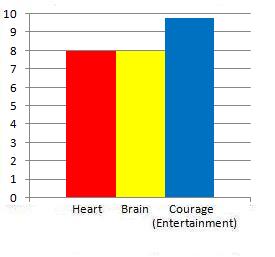
Easy Virtue
Directed by Stephan Elliott.
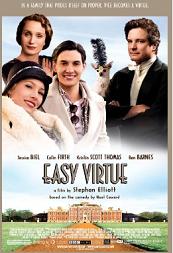
Based on the play by Noel Coward. Larita (Jessica Biel), a widowed racecar driver from Detroit, marries John Whittaker (Ben Barnes) in Monaco and arrives with him at the country estate of his family in England. Kristin Scott Thomas plays John’s stuck-up mother who welcomes Larita very coldly from the minute she steps out of the house to greet her. John’s father (Colin Forth) treats his new daughter-in-law with much more respect and warmth, though, compared the way that his wife and two daughters, Hilda (Kimberley Nixon) and Marion (Katharine Parkinson) do. Larita struggles to find a way to feel comfortable as a part of John’s family while trying not to let her mother-in-law get in the way and ruin his marriage. There’s also a silly subplot involving Larita accidentally crushing the family pet Chihuahua to death on a couch and getting help from the butler (Kris Marshall) to bury it in the backyard. The death of that little dog symbolizes Larita’s problems or issues, i.e. from her past, that she can’t seem to avoid or get rid of no matter how hard she tries to. Will her mother-in-law discover scandalous secrets from her past? Will she discover that the dead Chihuahua somehow? If you’re familiar with romantic comedies, the answers to those questions should be apparent from the very start of the film. One surprise, though, which won’t be spoiled here, comes in the form of a possible romance between Larita and someone else other than John. Director/co-writer Stephan Elliot moves the pace very briskly and blends comedy, drama and romance with mostly great results, except for the third act that feels too rushed and a bit lazy compared to the rest of the film. He also includes a very lively soundtrack that reminds you not to take what you’re seeing too seriously. In terms of comedy, some of the British humor falls flat, but for the most part it does manage to generate laughs with some witty one-liners. Admittedly, Elliott could have taken the comedy further to make it more consistently biting and funny rather than have it lose some of its oomph later on. Kristin Scott Thomas has a lot of fun in her deliciously mean role and delivers some of the funniest lines as does the charming-as-always Colin Firth. It’s quite diverting to watch Larita battle with her mother-in-law, much moreso than the wife and mother-in-law battling one another in the juvenile Monster-in-Law. Even though the laughs eventually fizzle out toward the end, Easy Virtue nonetheless manages to be unadulterated fun. At a running time of 93 minutes, it’s a sparkling, delightfully witty and frothy British comedy with a lively ensemble cast. Number of times I checked my watch: 1 Released by Sony Pictures Classics. Opens at the Regal Union Square 14, City Cinemas 1,2,3 and Lincoln Plaza Cinemas. 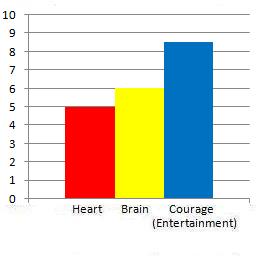
Ghosts of the Heartland
Directed by Allen Blumberg.
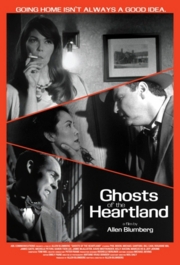
In 1952, Roland Lu (Phil Moon), a Chinese-American reporter, returns to his small hometown of Millville, to take care of his dying father. Upon his arrival, he discovers that the town’s mayor, Frank Dugan (Michael Santoro), wants to drive out the Chinese population living in Millville. Hoping to get a Pulitzer Prize, Roland musters up all the courage and journalism skills he has in order to expose the mayor’s racism and corruptions and to put an end to his immoral plans. It turns out that back in the 1930’s, the mayor of Millville and its Caucasian townspeople had driven out the American Indians in the town and, since then, Frank has tried to cover-up of that event. As Roland digs deeper to shed light on the cover-up and to warn the Chinese that history is about to repeat itself with them instead of the American Indians being persecuted, he gets himself into more and more trouble. Frank does everything in his power to destroy the evidence in an attempt to avoid a devastating scandal. Rosanne Ma plays Roland’s girlfriend, Liz, whom he hasn’t seen for a while and struggles to rekindle their romantic chemistry amidst those times of trouble. Meanwhile, Frank has a secret affair with a Chinese woman, Dorothy (Karen Tsen Lee). Writer/director Allen Blumberg gradually builds up tension as the plot grows more intricate. There’s a sense of foreboding danger as Roland uncovers the town of Millville’s past while its Caucasian townspeople are forced to confront it and question their morals. The truth may seem harsh and difficult to swallow for many, but it’s an important one that needs to be exposed, so it’s easy to root for Roland brings as darkness into the light of truth and justice, while becoming an activist. Blumberg also wisely includes stylish black-and-white cinematography that strengthens the film’s noirish atmosphere. Michael Santoro gives a convincing performance as the bigoted mayor, but, on the other hand, the rest of the cast give mostly mediocre performances at best. Admittedly, the romance between Roland and his girlfriend, Liz, does fall flat with contrivance, but it, fortunately, Blumberg keeps that subplot rather subdued while focusing much more on the Roland’s exposure of the town’s dark past, present racial tensions and political paranoia, during the appropriate running time of 80 minutes. Despite some forgivably mediocre performances, Ghosts of the Heartland manages to be a visually stylish noir film that’s often intriguing, suspenseful and provocative. Number of times I checked my watch: 3 Released by ABL Communications. Opens at the Quad Cinema. 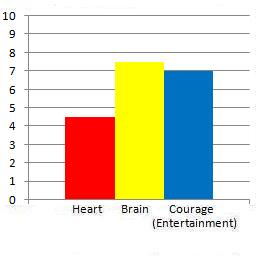
The Girlfriend Experience
Directed by Steven Soderbergh.

A few weeks before the Presidential Election of 2008, Chelsea (Sasha Grey), a Manhattan call girl who charges her clients $2,000 per hour, wants expand her market to make even more money so that she can fulfill her dream of opening her own boutique. She lives in a nice apartment with her boyfriend, Chris (Chris Santos), an athletic trainer who doesn’t mind her being in that kind of line-of-work because they both share the strong desire to become wealthier and wealthier. But what might happen to intangible things such as happiness and love? Whether Chelsea interacts with a man (Glenn Kenny) who calls himself The Erotic Connoisseur to boost her career, or with a Hassidic Jeweler who she also screws, she’s living a very cold and mundane life. After she gives all of her clients a “girlfriend experience,” so-to-speak, she comes home to Chris and has dinner with him, but they don’t really have any deep, intimate discussions with one another. Perhaps beneath her confidence about showing off her body, among doing other things with it, she’s very insecure and naïve. Chris doesn’t seem too bright, mature or genuinely warm as a person, although he does care about Chelsea and at least he think that he wants to continue being with her. When Chelsea tells him that she’ll be spending an entire weekend with a client, he gets jealous and questions their relationship as it deteriorates even further. Simply put, she’s just not that into him. Writer/director Steven Soderbergh plays around with the chronology of the scenes so that some flash forward while others flash backwards in time, so he expects the audience to piece it all together in the end. Not much really happens in terms of plot, but with the camera fixated so often on Chelsea and with her voice-over, you’re able to somewhat grasp what’s going on inside her head. Soderbergh uses tone, cinematography, pacing and choices of color in interesting, stylish ways that recall the films of Godard. There are plenty of nude scenes to be found with Sasha Grey, but those scenes don’t quite go beyond the level of softcore porn. Showgirls seems sleazier by comparison. Grey certainly looks sexy and seductive and, given that this marks her feature film debut in a non-adult film, she gives a decent performance here. Ultimately, The Girlfriend Experience manages to be a visually stylish, sexy and provocative film that's emotionally cold, yet oddly intriguing. Number of times I checked my watch: 2 Released by Magnolia Pictures. Opens at the Beekman Theatre, Clearview Chelsea and Landmark Sunshine Cinema. 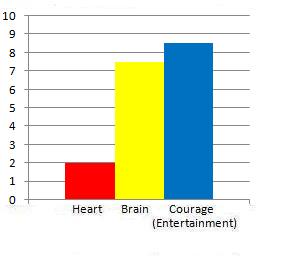
Kabei: Our Mother
Directed by Yôji Yamada.

In Japanese with subtitles. In 1940 Japan, Shigeru Nogami (Mitsugoro Bando), a.k.a. Tobei, a college professor, enjoys a nice meal at home with his wife, Kayo (Sayuri Yoshinaga), a.k.a. Kabei, and two daughters. Later that night, the police arrive to throw him in jail for expressing his anti-war thoughts in writing. The fascist Japanese government expects every citizen to proudly support the war against China and anyone who dissents, no matter what reason, is labeled as a traitor. While in jail, Tobei writes a recantation as an attempt to finally be set free, but the government doesn’t approve of the recantation. It takes Kabei a while to learn how to successfully send items to Tobei without reservedly accepting a “no” for an answer when approaches the employees at the jail. Meanwhile, his daughters write letters to him and he replies. When Toru Yamasaki (Tadanobu Asano), a.k.a. Yamazaki, Tobei’s former student, shows up at his home, Kabei welcomes him and invites him for dinner there. He gradually becomes a more integral part of Tobei’s family and helps Kabei through all of her emotional struggles. At one point, Kabei visits her father (Umenosuke Nakamura), a policeman, who thinks that she’s just like her husband because she hasn’t divorced him, this continuing to put her family through hardships. However, in a simple, yet powerful scene, she defends her unconditional love of Tobei even as he sits in jail. Sayuri Yoshinaga delivers a convincingly moving and well-nuanced performance that helps to keep you fully immersed in the film. Director/co-writer Yôji Yamada has crafted a very sensitively written and tender drama that never veers toward melodrama or soap opera territory. Each character comes to life in a way that heightens the realism of many scenes. Most importantly, you’re able to feel the palpable chemistry between Tobei and Kabei as husband and wife even until the emotionally devastating third act, which won’t be spoiled here. The same can be said for the strong bond between Tobei and his daughters. Yamada also moves the scenes at an appropriate leisurely pace and includes small details that represent something more significant than meets the eye, such as a simple gift of flowers that Kabei sends to Tobei. At a running time of 2 hours and 13 minutes, Kabei: Our Mother, manages to be an unpretentious, engrossing, well-nuanced and tender drama brimming with a raw and powerfully moving performance by Sayuri Yoshinaga. Number of times I checked my watch: 1 Released by Strand Releasing. Opens at the Quad Cinema. 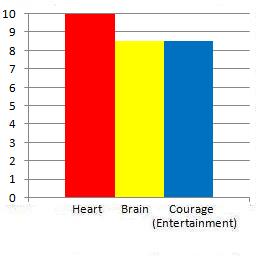
Milton Glaser: To Inform & Delight
Directed by Wendy Keys.
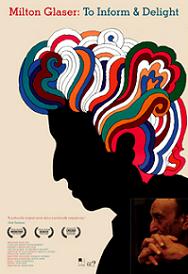
This engaging and insightful documentary focuses on the work of Milton Glaser, a graphic designer who co-founded New York Magazine. Throughout his career, he invented the very simple yet iconic design for the “I Heart NY” logo as well as signs in supermarkets and even posters, such as one of Bob Dylan with stylized, colorful hair. His work even extends to paintings and album covers. Director Wendy Keys includes many illuminating interviews with Milton Glaser as he candidly discusses his past artworks and the thought processes behind how he designed them. Although Keys does show Glaser with his wife at his current home, she doesn’t delve into his personal life or background beyond his significance in the world of art. Much of his art reflects who he is and what he was thinking, such as anti-Bush buttons that he designed which have written on them the bold statement, “‘W’ Stands for Wrong.” In a particularly revealing interview, he explains how stupidity can be found more and more in the world of today---it would have been helpful had he elaborated more about that interesting point. Glaser radiates plenty of charisma and intelligence throughout his interviews. You’re able to grasp that he’s so impassioned about art. Fortunately, he knows how to express his understanding of it so effectively and articulately. He’s the kind of person who not only talks a lot, but actually says a lot, too. He says what he means and he means what he says, unlike some artists who seem so repetitive and bland when they speak. At the same time, he comes across as quite warm, charismatic and down-to-earth. At a running time of only 73 minutes, Milton Glaser: To Inform & Delight manages to be an illuminating, compelling and well-focused documentary. Just like Milton Glaser’s artworks, it concurrently informs and delights. Number of times I checked my watch: 1 Released by Arthouse Films. Opens at the Cinema Village. 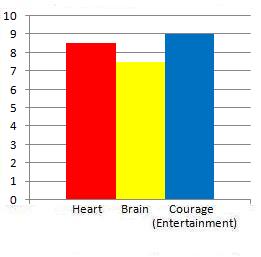
New World Order
Directed by Luke Meyer and Andrew Neel.
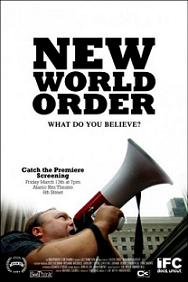
This provocative documentary focuses on the efforts of conspiracy theorists who devote their time and energy to exposing the conspiracy that 9/11 was an inside job and that there’s a group of elitists, called Bilderberg Group, from around that world, who meet at an invitation-only conference. According to radio host, activist and filmmaker Alex Jones, the Bilderberg Group plans to start a “new world order” which would enslave everyone around the world through money and power. Alex wants to find out the truth about what’s going on during that conference, but he and his team can’t even get into the building and, instead, as he stays around the area, he’s kept under surveillance and followed as if he were an assassin. At one instance, he was detained and interrogated by Canadian immigration. If you’ve read Naomi Wolf’s The End of America, you would remember that a few of the steps of a “fascist shift” include such acts as setting up a surveillance system, arbitrarily releasing and detaining, and controlling the press, which are three steps that the Bilderberg Group have taken to stop Alex Jones from exposing the truth—no matter what that truth may be. Alex has every right to ask questions and to express his feelings of anger and skepticism. He’s an integral part of democracy while anyone who tries to suppress him, without opening up a thoughtful discussion, would be closing down democracy. There’s also Jack McLamb, an ex-police officer from Phoenix, Arizona who decided not to conform to the aggressive tactics that other policemen in the U.S. were instructed to do, moved up to an Idaho mountaintop where he speaks out on his own radio show, The Officer Jack McLamb Program, and also formed the group “Police and Military Against the New World Order.” Then there’s Seth Jackson, a Katrina relief aid worker who doesn’t believe in aliens, but does believe in the conspiracy that 9/11 was an inside job. He exposes the cover-up to strangers and openly discusses his thoughts and beliefs, even a pedestrian who happened to have worked at the Pentagon during 9/11. Other brave conspiracy theorists include Luke Rudkowski, a 21-year-old activist who spends his time trying to raise awareness about that 9/11 conspiracy as well. He founded the activist organization We Are Change, hands out free informational DVDs and participates in protests along with Alex Jones. He agrees, just like any intelligent and honest person would, that there ought to be an independent investigation of 9/11 to uncover the truth behind the fog of government propaganda, cover-ups and lies. Not surprisingly, Alex encounters enraged people throughout his protests, such as a man in a business suit who walks by and yells at him to shut-up and to get out of the country. That man represents a microcosm of the stupidity and ignorance of most American citizens who just aren’t willing to step outside their little bubble of psuedo-comfort, to open their mind, to ask questions, to listen, to think and to stop being so simple-minded. That doesn’t mean that they or you or anyone ought to agree with the conspiracy theorists or anyone else for that matter. By not including voice-over narration, preachiness or critiquing the thoughts of conspiracy theorists, co-directors Luke Meyer and Andrew Neel wisely trust you, as an intelligent audience member, to formulate your own opinions about what you’re hearing. They’re not telling you what to think, but, instead, they're inspiring you to think and to ask questions, which should promote discussion and democracy while getting all of us closer to the truth without any euphemisms. Ultimately, New World Order manages to be a timely, provocative, vital and eye-opening documentary. Number of times I checked my watch: 0 Released by SeeThink Films. Opens at the Cinema Village. 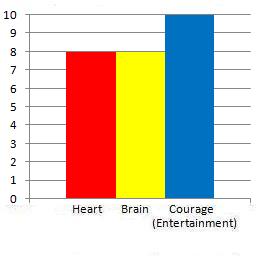
Night at the Museum: Battle of the Smithsonian
Directed by Shawn Levy.
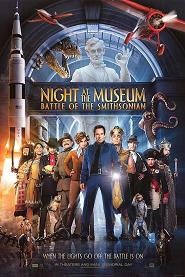
Ben Stiller returns as Larry Daley, an ex-museum night guard who’s now a successful inventor of infomercial products, such as a flashlight that glows in the dark. One day, upon visiting the Museum of Natural History where he had once worked at, he learns from museum director Dr. McPhee (Ricky Gervais) that all of his beloved exhibits, such as the miniature cowboy Jedediah (Owen Wilson), miniature Octavius (Steve Coogan), Teddy Roosevelt (Robin Williams) and Dexter, the adorable capuchin monkey, that literally come-to-life at night, will be shipped off the Smithsonian museum located in Washington, D.C. Once they arrive at the Smithsonian, Jedediah calls Larry ro request his assistance because the other exhibits at the museum have come alive. Hank Azaria plays the silly yet hilarious role of Kahmunrah, an ancient Egyptian ruler who holds Jedediah hostage inside an hour glass. He wants Larry to decipher the secret code of a tablet so that he can use it to awaken an army that will rise up to conquer the world. Other villains, such as Napoleon Bonaparte (Alain Chabat), Ivan the Terrible (Christopher Guest and a black-and-white Al Capone (Jon Bernthal) help him with his evil plans. Throughout his adventure, Larry meets a variety of people, such as the bubbly Amelia Earhart (Amy Adams), who becomes his sidekick along the way, General Custer (Bill Hader), Abe Lincoln (voice of Hank Azaria) and a bunch of small Albert Einstein dolls (voiced by Eugene Levy) who eventually all assist him as well in different ways. Fortunately, the screenplay by co-writers Robert Ben Garant and Thomas Lennon has enough imagination and witty dialogue to keep you thoroughly entertained and amused. The plot doesn’t take itself too seriously, yet little kids will be able to learn the basics of American and World history, without being bored, just by watching the new characters come to life onscreen and interact with Larry. Every member of the cast seems to be having a lot of fun in their roles, whether they’re brief ones like Jonah Hill’s as a security guard or the larger ones like the charismatic Amy Adams as Amelia Earhart. There’s a brilliantly innovative and memorable sequence when Larry and Amelia walk directly inside of an animate painting, which won’t be spoiled here, and a surprisingly sweet one with singing cherubs. Director Shawn Levy has brought back the delightful magic that audiences experienced in the first Night at the Museum. He moves the pace briskly enough with plenty of action/adventure sequences and dazzling special effects so that there’s never a moment that drags. At a running time of 105 minutes, Night at the Museum: Battle of the Smithsonian manages to be an exhilarating, imaginative sequel filled with humor, excitement, wit and a lively cast. It’s genuinely delightful and fun for everyone young and old. Number of times I checked my watch: 0 Released by 20th Century Fox. Opens nationwide. 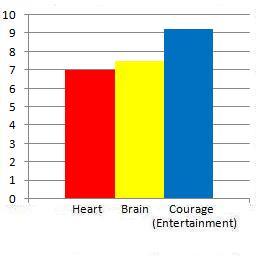
Main Page
Alphabetical Menu
Chronological Menu
______________________________________________________
|
















